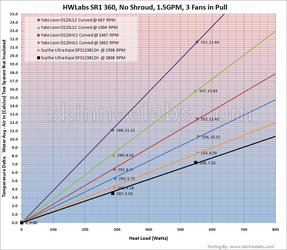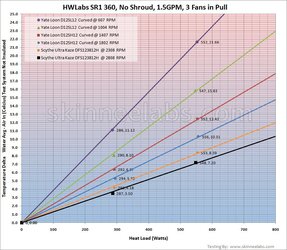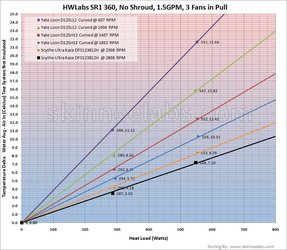[PLAIN][B][SIZE=4][COLOR=silver]Welcome to the much needed Water-cooling Heatload Explanation.[/COLOR][/SIZE][/B]
[COLOR=silver]A water-cooled PC, or any pc, generates heat. Some parts produce massive amounts of heat due to the incredible number of calculations needed to give us what we crave, realistic games, Folding for our future, and decoding DVDs for our own personal use. I'm going to focus on two parts of your PC, the CPU and the GPU. These are the main hot parts we need to cool. I'll touch on a few other critical issues you need to understand as I hack my way through this.[/COLOR]
[SIZE=2][COLOR=silver][B]Why Am I Doing This?[/B][/COLOR][/SIZE]
[COLOR=silver]I used to teach electronics to young folks, I've been water cooling for a few years, so I think I can help get the concept of Heat-load across to any new person looking to expand their knowledge and build a really nice rig. Understanding the big picture, answering the eternal Forum question, "What stuff do I need to cool my rig"? [/COLOR]
[COLOR=silver]Most importantly, I must mention all the testers who post scientific tests and not hack reviews or this post wouldn't exist. These are people who for science and curiosity spent $100s++ of their own money and time building testing rigs, and COUNTLESS hours of their personal time to inform us, the uniformed public. I thank you Martin and Skinnee, you're an amazing part of our water cooling world. There are a few others, but they are leaders.[/COLOR]
[SIZE=2][COLOR=silver][B]Done with the intro, on to the important stuff.[/B][/COLOR][/SIZE]
[COLOR=silver]Okay, you've got an xx processor. How much heat does it generate under load? Heat is produced by the voltage and the amperage draw your CPU needs. Increasing voltage really increases your heat-load as do your overclocks. If a CPU uses 200 watts of power, about 80% to 90% will be lost as heat as the work is done in the CPU. It's deep electronic stuff, just go with it okay? You have to remove the heat.[/COLOR]
[SIZE=2][COLOR=silver]You can describe your created heat-load in three ways (or activities):[/COLOR][/SIZE]
[COLOR=silver]1. Basic cruzin the web[/COLOR]
[COLOR=silver]2. Gaming[/COLOR]
[COLOR=silver]3. Benching for the best overclocks[/COLOR]
[SIZE=2][COLOR=silver]Consider the following, all of them come into play when determining how to deal with said heat:[/COLOR][/SIZE]
[COLOR=silver]1. Your budget[/COLOR]
[COLOR=silver]2. Acceptable noise levels[/COLOR]
[COLOR=silver]3. What can you fit in your case[/COLOR]
[COLOR=silver]4. Expected cooling capability meaning low temps or acceptable temps. [/COLOR]
[COLOR=silver][SIZE=2][B]Determining your heat-load isn't a perfect science.[/B][/SIZE] [/COLOR]
[COLOR=silver]You'll find numbers all over the place from what you have learned from reading lots of info, Googling terms like "heat-load i7 965", "AMD xxx", "Q6600 overclocked", etc. Reading 3-7 pages of Google, and following links within the Goggle links, you should have an idea of what wattage you create in your PC furnace.[/COLOR]
[SIZE=2][COLOR=silver][B]CPU heat-load[/B][/COLOR][/SIZE]
[COLOR=silver]For example, I remember a Q6600 at 3.9 was 150 watts MAX. An i7 at 4.0 is 250 watts. Right now, as I type, my i7 965 stock is at 80 watts. My peak load is 340 watts, but for a very, very short time. So take the min/max with a grain of salt. These are max testing loads, so real world is a bit lower if you're a big gamer. I'm making a point, it's a lot of heat and you need to remove it. I use 250 watts as my stress wattage for calculations on MY chip.[/COLOR]
[SIZE=2][COLOR=silver][B]GPU Heat-load[/B][/COLOR][/SIZE]
[COLOR=silver]GPU's are a big issue now. Some are moving to water-cooling, having never done it before, just because their GPU screams like a undead banshee while gaming. I have these neat links from another forum. From what others have said these folks did a TON of work and are trusted. They were able to look at JUST the GPU heat-loads on many cards, not full system power, which really isn't what we need here.[/COLOR]
[COLOR=silver]Bookmark it![/COLOR]
[URL="http://www.overclockers.com/forums/s...d.php?t=635806"][COLOR=silver]http://www.overclockers.com/forums/s...d.php?t=635806[/COLOR][/URL]
[COLOR=silver]Please, I ask you to attempt to find out your heatload before we move on.[/COLOR]
[SIZE=2][COLOR=silver][B]How basic WC works in relation to heatload.[/B][/COLOR][/SIZE]
[COLOR=silver]We generate xx amount of heat. The heat is transferred to the water via the blocks on the CPU and GPU. The cooler the water, the more heat is transferred. As the water heats up the heat is removed by the radiator. The more efficient the fan/radiator combination is, the cooler the water. The cooler the water, the cooler your parts. So simple. Basic water-cooling uses a pump, res, a block, a radiator, AND ambient air temp. Our water can be no cooler than the air temp. A room at 12C will keep the chips much cooler than a room at 30C. Remember this!. Summers are much hotter and many back off on their overclocks in the summer. Funny thought, I just realized more people mention chilled water, mini fridges, etc., in the summer. And if you try to compare to someone else, remember ambient room temps and even the quality of the chip matters.[/COLOR]
[SIZE=2][COLOR=silver][B]Delta T (DT) and why it's so important to understand it.[/B][/COLOR][/SIZE]
[COLOR=silver]DT is the foundation of your WC loop. The better your DT, the cooler your chips are. In water-cooling DT is simply the difference between the ambient air temp and the water temp on the outgoing side of the rad. Room temp vs. water temp, that's it. You can't remove all the heat nor can you go below ambient room temp. [/COLOR]
[COLOR=silver]When you boot up a powered off, water-cooled PC, the water temp AND your CPU are at room temp. You boot the PC up, the chip gets hot FAST, almost instantly. The water moves over the chip, it begins to remove heat, the heat goes to the radiator, and SOME of the heat is removed. Not all can be removed. You have to know thermodynamics theory deeply (more than me) to know exactly why. The water begins to warm up slowly, and in time, the water reaches a balance, an equilibrium is reached. Heat is made and heat removed, the loop is stabilized, temps will not change. [/COLOR]
[COLOR=silver]If you change the room temp, the load, or your fan speed the loop needs to readjust. This is where we like to measure our cooling ability. usually 30 minutes at a stable load is long enough to begin to measure. If you increase your cooling capability, the water WILL get cooler. [/COLOR]
[COLOR=silver]Water temps in a stabilized loop, amazingly, are very similar anywhere in the loop. Only 2-3C MAX difference between the radiator out temp and the CPU out temp. Remember, the water can't remove all the heat, some is transferred to the air. Your radiator size, efficiency and fans play a big part in this. Look at it this way, it's a system built on many parts and within the laws of physics. Every part affects the other.[/COLOR]
[SIZE=2][COLOR=silver][B]Let's talk about what a good DT is.[/B][/COLOR][/SIZE]
[COLOR=silver]A CPU loop needs good DT. Under 10C is just fine, getting closer to 5C is very nice and important if you want big overclocks. Getting under 5C is just overdoing it, unless you're very extreme, need it for benching or just want to do it. On an average CPU loop shoot for under 10C and adjust your overclocks to be fine under the temps suggested by the makers.[/COLOR]
[COLOR=silver]A GPU loop used to be fine with a 15 to 20C DT. If you're a big overclocker on your GPUs, then shoot for 15C or lower. The Voltage Regulator Modules (VRM) on these new cards can be affected by temps. If you've got a GTX 280 like me, don't worry about it, it's the 5970s and the 480s and other really hot cards that can have this issue. So a lower DT for a GPU loop if your a big overclocker might be needed. Thats up to you as you design your setup.[/COLOR]
[SIZE=2][COLOR=silver][B]So, how do you calculate all of this?[/B][/COLOR][/SIZE]
[COLOR=silver]Use a bit of math, deciphering some graphs, it's easy! LOL, jk. Took me more than a few attempts to figure it out, but you can easily do it with help. Thanks to Martin (retired) and Skinnee we have the data. Bless them.[/COLOR]
[COLOR=silver]Let's go with my CPU standard of 250 watts and this link. Link to it please, then go to page 4. Read it all when you get a chance.[/COLOR]
[URL="http://www.skinneelabs.com/hwlabs-sr1360.html?page=4"][COLOR=silver]http://www.skinneelabs.com/hwlabs-sr1360.html?page=4[/COLOR][/URL]
[COLOR=silver]This is a quality radiator with low fins per inch, great for low RPM, low noise fans.[/COLOR]
[COLOR=silver]Go to the second chart, use the RED line. It's a good quality, popular, well performing fan at 1407 RPM, good middle ground. At the bottom of the chart find 250 watts, go up to the red line. WOW We have a 5.5 DT, very nice. Remember my comment about a CPU likes low DT but a GPU doesn't need it as much? Let's toss a 250 watt GPU into the same loop, your at 500 watts now. Res-Pump-Rad-CPU-GPU type loop. Look what happens to the DT, it's over 11DT now. Your CPU isn't happy anymore, but the GPU is just fine. In this case you're under radded and need to split the loop or get your DT under control with more fannage, better radiators/more radiators, better fans. More heat removal basically.[/COLOR]
[SIZE=2][COLOR=silver][B]Remember this?[/B][/COLOR][/SIZE]
[COLOR=silver]1. Your budget[/COLOR]
[COLOR=silver]2. Acceptable noise levels[/COLOR]
[COLOR=silver]3. What can you fit in your case[/COLOR]
[COLOR=silver]4. Expected cooling capability meaning low temps or acceptable temps [/COLOR]
[COLOR=silver]In many situations splitting the loop is so much easier to keep temps under control. You can only put so much in one loop. Splitting the loop means having one fully separate loop for the CPU and one for the GPUs. Two pumps, two rad setups, two reses etc. It was uncommon a few years ago unless you had 2+ GPUs. Now the GPUs are incredibly hot and it's slowly becoming the norm. It costs more, keeping the CPU temp low on it's own loop and having a higher DT loop just for the GPU. [/COLOR]
[COLOR=silver]Sorry, but many of us do have a massive GPU setup these days. You wanna play right with water-cooling? You pay. You can easily go past your budget once you start. It's amazing what a proper water-cooling setup costs.[/COLOR]
[COLOR=silver]Lots start out with the wrong radiator type or much too little radiator. Some think they can live with the high speed fans to compensate for too small rads, but end up buying another radiator and trying to fit it in the case. Many times you just have to accept your beloved case isn't going to work, or you're going to have to hang rads on the outside, or even make a separate rad box. You can't trick physics and think you don't need all the radiators you actually do need.[/COLOR]
[COLOR=silver]In summary, do your homework, plan for your rig and the 1 year out rig. You see another GPU in crossfire? Plan now.[/COLOR]
[COLOR=silver]Your DT matters, it's worth the effort to understand.[/COLOR]
[COLOR=silver]Thanks to all the input from many OCF members to get this cleaned up for Sticky use. I hope it guides many new folks to making the right choices.[/COLOR][/PLAIN]





